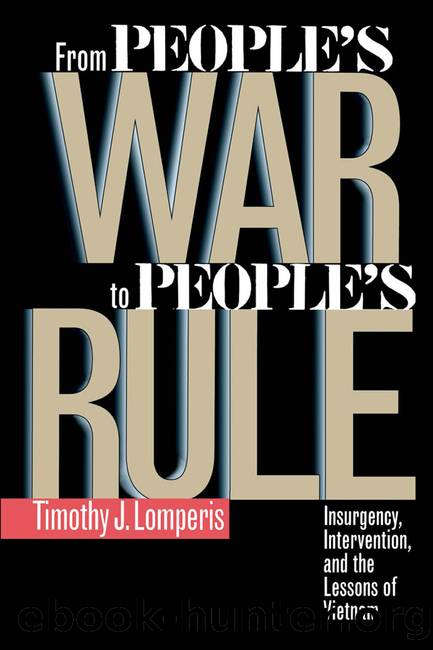From People's War to People's Rule: Insurgency, Intervention, and the Lessons of Vietnam by Timothy J. Lomperis

Author:Timothy J. Lomperis [Lomperis, Timothy J.]
Language: eng
Format: epub
Tags: Political Science, History & Theory
ISBN: 9780807863046
Google: 1j_qCQAAQBAJ
Goodreads: 21880723
Publisher: Univ of North Carolina Press
Published: 1996-09-01T00:00:00+00:00
Framework Analysis
NATIONAL LEGITIMACY
When the French abandoned their attempt to reimpose their âprotectionâ over Indochina at the Geneva Accords of 1954, the former colonies sought to reclaim their precolonial political traditions even as they tried to build modern nation-states. Cambodia and Laos, in particular, endeavored to fashion a bond between traditional Buddhist principles of kingship as symbols of national identity and the modern republicanism of a Charles De Gaulle and the professionalism of the Ecole Polytechnic as foundations for functioning modern states. Both embarked on a creditable path of national and local elections to build the ties and sentiments of a middle-ground-based polity. But the fractures engendered by this transition were too great for these bridges, and, by the mid-1960s, in both Cambodia and Laos, this process of nation-building had frozen up. Instead, they were swept over first by a wave of revolution coursing over peninsular Southeast Asia and then by a second wave of foreign interventions as the two global power blocs struggled to turn this first wave to their own geopolitical channels. The drowning effect of these waves can be seen most clearly in the analysis of the asymmetries, errors, and reversibilities to the Cambodian and Laotian revolutions. They were so bound up in the larger war in Vietnam that none of the changes discussed really could have been possible unless they were tied to changes originating in the Vietnam War itself. As terrible as they were to their own people, the revolutions in Cambodia and Laos truly were âsideshows.â
As for national legitimacy in Cambodia, at the interest level, the government was able to provide material incentives, both positive and negative, that were sufficient until 1963 to keep the lid on revolutionary activity. This was reflected by Prince Sihanoukâs ability to smash the rural network of cadres in 1959 and either repress or co-opt the communists in the cities. According to the communist theoreticians Hu Nim, Hou Yuon, and Khieu Samphan, the years 1963 to 1967 brought increasing misery to the peasantry. Landholding became more concentrated, and poorer peasants were forced by their indebtedness to become sharecroppers, perhaps as many as 25 percent. Other studies cast some doubt on this thesis of rural misery. Jean Delvert found rural indebtedness a greater problem than land, and a cooperative movement did mitigate this somewhat. This fragmentation of landholding may also be explained by a marked shift from 1963 to 1968 away from rice paddy to the farming of cash crops. These were all cultivated on smaller plots but yielded double to quadruple the returns of paddy. There was, however, a discrepancy in rural and urban incomes, which caused tensions.87
Whatever the rising or falling of peasant misery, the communists showed no capabilities of exploiting it. Even the tinderbox at Sumlaut merely served to rouse the communists momentarily. For the next three years, except in tribal areas in the Northeast, they floundered. The 1970 coup and the five-year war that followed brought two changes to the sociopolitical landscape, besides the Sihanouk crossover. First, people flocked to the cities.
Download
This site does not store any files on its server. We only index and link to content provided by other sites. Please contact the content providers to delete copyright contents if any and email us, we'll remove relevant links or contents immediately.
| Central Asia | Southeast Asia |
| China | Hong Kong |
| India | Japan |
| Korea | Pakistan |
| Philippines | Russia |
The Sympathizer by Viet Thanh Nguyen(4305)
The Rape of Nanking by Iris Chang(4137)
World without end by Ken Follett(3428)
Ants Among Elephants by Sujatha Gidla(3417)
Blood and Sand by Alex Von Tunzelmann(3138)
Japanese Design by Patricia J. Graham(3109)
City of Djinns: a year in Delhi by William Dalrymple(2514)
The Queen of Nothing by Holly Black(2492)
Foreign Devils on the Silk Road: The Search for the Lost Treasures of Central Asia by Peter Hopkirk(2434)
India's Ancient Past by R.S. Sharma(2416)
Inglorious Empire by Shashi Tharoor(2395)
Tokyo by Rob Goss(2389)
In Order to Live: A North Korean Girl's Journey to Freedom by Yeonmi Park(2346)
India's biggest cover-up by Dhar Anuj(2318)
Tokyo Geek's Guide: Manga, Anime, Gaming, Cosplay, Toys, Idols & More - The Ultimate Guide to Japan's Otaku Culture by Simone Gianni(2314)
The Great Game: On Secret Service in High Asia by Peter Hopkirk(2305)
Goodbye Madame Butterfly(2203)
Batik by Rudolf Smend(2124)
Living Silence in Burma by Christina Fink(2038)
